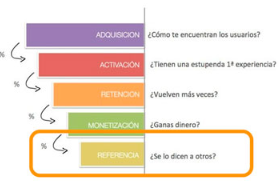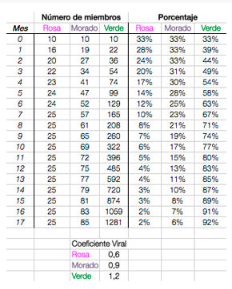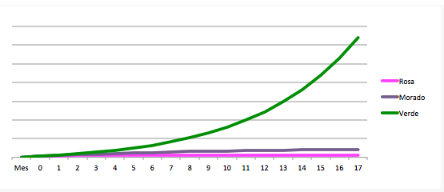VIRALIDAD DE TUS VENTAS PARA CONSEGUIR UN CRECIMIENTO EXPONENCIAL
Acelera tu empresa con estos consejos de expertos sobre «Viralidad de tus ventas para conseguir un crecimiento exponencial». ¡Analiza y descubre esta TIP!
La viralidad es un factor poderoso que puede acelerar el crecimiento de una empresa de manera significativa. Conseguir la viralidad de las ventas es fundamental para cualquier negocio que busque un crecimiento rápido y efectivo.
¿Cómo crecer aprovechando la viralidad en las ventas?
- Analizar Datos y Comportamientos del Usuario: utiliza herramientas de análisis para rastrear cómo los usuarios interactúan con tu producto o servicio. Identifica qué características o contenidos generan más interacción y considera cómo se podrían mejorar para aumentar la viralidad.
- Pruebas A/B para Optimizar el Funnel de Conversión: utiliza pruebas A/B para ajustar y mejorar cada etapa del embudo de conversión. Cada mejora en el embudo aumenta la efectividad del coeficiente viral.
- Identificar y Activar Promotores: aprovecha las métricas Net Promoter Score (NPS) para identificar a los clientes más satisfechos y encontrar maneras de incentivarlos a compartir su entusiasmo con otros.
- Mejorar el Producto en Base al Feedback: utiliza el feedback de los usuarios para realizar mejoras constantes. Un producto que satisface o supera las expectativas del cliente es más probable que se comparta.
- Retención de Usuarios: la viralidad no solo trata de adquirir nuevos usuarios sino de retener a los existentes. Un usuario satisfecho y recurrente tiene más posibilidades de referir a nuevos usuarios.
- Gamificación: introduce elementos de gamificación que incentiven a los usuarios a realizar acciones que incrementen la viralidad, como compartir contenido, invitar a amigos, etc.
- Incentivos y Recompensas: como mencionaste, ofrecer incentivos para compartir puede ser un impulsor poderoso de la viralidad. Esto podría incluir descuentos, acceso a funciones premium, etc.
- Monitorizar y Ajustar: la viralidad es un objetivo móvil. Lo que funcionó ayer podría no funcionar mañana. Es esencial seguir monitoreando las métricas y estar dispuesto a adaptarse rápidamente.
¿Es posible medir la viralidad?
Definitivamente sí.
AQUÍ HAY ALGUNAS MÉTRICAS ADICIONALES QUE PODRÍAN CONSIDERARSE:
- Tiempo hasta la Conversión: ¿Cuánto tiempo toma en promedio desde que un usuario se entera de tu producto hasta que realiza una acción deseada, como hacer una compra o registrarse?
- Cohortes de Usuarios: dividir a los usuarios en cohortes basados en cuando se unieron te permitirá ver cómo las diferentes estrategias afectan la viralidad a lo largo del tiempo.
- Coste de Adquisición de Cliente (CAC) (+) frente a Valor de Vida del Cliente (LTV): si el LTV supera al CAC y tienes un alto coeficiente viral, estás en una posición excelente para crecer.
Recordando que la viralidad es una métrica de crecimiento que realimenta la capacidad de adquisición de nuevos usuarios, las empresas que logran un coeficiente viral alto están bien posicionadas para experimentar un crecimiento significativo. Y como se menciona, si el coeficiente es mayor que 1, estás en un territorio de crecimiento exponencial, lo cual es el objetivo final de muchas startups y empresas en crecimiento.
El coeficiente viral… ¿Es posible medir la viralidad?
Si hay un factor que puede transformar un modelo de negocio es la viralidad. Se trata de una característica capaz de producir crecimientos sorprendentes con curvas exponenciales… pero a pesar de que existe un aura mítica sobre el elemento viral, en realidad es un factor que se puede medir, es el primer paso antes de poder mejorarlo ¿sabes cómo hacerlo?
Como creo que resulta evidente, soy un enamorado de las métricas, ya que creo que «El primer paso para poder mejorar algo es poder medirlo» como decía Drucker. Y por eso a menudo cuando trabajo con clientes se sorprenden de que consigamos establecer métricas del factor viral, ya que se ha convertido en un elemento mítico que parece que únicamente aparece si los dioses son propicios.
Aunque no es el objetivo último de este post plantear los factores que conducen a la viralidad (hay grandes artículos sobre cómo implementar o diseñar la viralidad), sí que trataremos de aislar los factores sobre los que se construye, y sobre todo, estableceremos una métrica: el famoso coeficiente viral o k-factor.

Para mí, el primer paso es comprender que la viralidad realmente es (habitualmente) el último escalón del embudo de conversión de un modelo de negocio (+), y que por tanto debemos comprender que es una métrica de crecimiento… ya que realimenta la capacidad de adquisición de usuarios: a mayor viralidad, mayor número de nuevos usuarios.
¿QUÉ ES EL COEFICIENTE VIRAL Y CÓMO MEDIRLO?
La mayor parte de la gente, cuando se dedica a medir la viralidad únicamente mide aspectos relacionados directamente con su ego como el número de invitaciones enviadas, el número de comparticiones del contenido en la red social de turno o las visualizaciones de un video… pero ¿y el proceso de viralización que subyace? Ahí es donde está el elemento clave a medir.
Y sí, estoy hablando en general de modelos de negocio basados en la tecnología. No porque no exista la viralidad en modelos de negocio «físicos» o porque no se pueda medir, sino porque el proceso resulta mucho más complicado, dado que falta un factor clave: la trazabilidad (y que hay que utilizar tácticas más complejas para implementarlas como afiliación o bonos, descuentos x invitación…etc.)
EL COEFICIENTE VIRAL, O AL MENOS LA DEFINICIÓN QUE MÁS ME GUSTA DE JEREMY LIEW, ES:
«Representa la capacidad de crecimiento viral de un sitio, y mide el número medio de usuarios nuevos que es capaz de traer un usuario actual».
NADA MEJOR QUE UN EJEMPLO PARA ENTENDERLO
Imagina una plataforma con 3 perfiles o tipos de usuario: los ROSA, los MORADO y los VERDE.
Cada grupo empieza con 10 usuarios, pero tiene diferentes coeficientes virales: el ROSA=0.6, el MORADO=0.9 y el VERDE=1.2. Con el paso del tiempo mira lo que pasa con los porcentajes de usuarios en cada grupo.
Como puedes ver, la diferencia es abismal, y en muy poco tiempo los usuarios VERDE crecen de forma espectacular.
PRIMERA CONCLUSIÓN

“Si el coeficiente viral es >1, la plataforma es exponencial y orgánica (es decir, cada usuario trae al menos a otro nuevo). Si es menor que 1, la plataforma crece de forma lineal”.

REALMENTE, PARA PODER MEDIR ESE COEFICIENTE VIRAL HAY 2 FORMAS:
- Proyectos donde es posible medir invitaciones o viralización: es decir, en proyectos donde al lanzar una nueva invitación o compartir algo es posible identificar de forma unívoca al usuario que ha invitado. Por ejemplo, con plataformas donde cada invitación tiene una URL especial y trazable, de forma que podemos atribuirle a un usuario en concreto. En éste tipo de escenario hay dos métricas básicas para construir el coeficiente de viralidad.
- Ratio de invitación: Mide el número medio de invitaciones enviadas por los usuarios de la plataforma en un periodo dado. La única forma «natural» de mejorarlo es hacer que tu producto o servicio sea tan genial que la gente quiera recomendarlo a sus amigos.
- Por ejemplo, durante el periodo de verano en la plataforma de uno de mis clientes (un proyecto que opera con el concepto habitual de invitación) se enviaron 112.000 invitaciones aprox. lo que representa 2,07 invitaciones por usuario (había 54.000 al empezar el período, por lo que es 112.000/54.000).
- Ratio de aceptación: Mide el porcentaje de invitaciones aceptadas (o ratio de conversión de las invitaciones que se han aceptado vs. invitaciones enviadas). Cuanto más clara y potente sea la invitación, el proceso de alta y los incentivos de aceptación, mayor será el ratio.
- Por ejemplo, en el anterior cliente el ratio de aceptación durante el verano fue del 27%, lo que quiere decir que algo más de 1 de cada 4 invitaciones acaba en el registro de un nuevo usuario…
EN ESTE TIPO DE PROYECTOS, LA FÓRMULA PARA CALCULAR EL COEFICIENTE VIRAL ES MUY SENCILLA (DONDE U ES «USUARIOS»):
«U. Virales= U. Iniciales x Ratio invitación x Ratio aceptación
Coeficiente viral= U. Virales / U. Iniciales»
En el caso de mi cliente, que partía de 54.000 usuarios antes del verano, y si aplicamos la fórmula anterior, veremos que en total se consiguieron 30.240 nuevos usuarios de forma vital (54.000 x 2,07 x 27%, una cifra respetable, pero lineal), lo que implica un coeficiente vital de 0,56 (30.240/54.000). Para que el coeficiente viral fuera 1 sus usuarios deberían haber enviado 200.000 invitaciones o haber conseguido un ratio de aceptación de algo más del 48%.
UNA FORMA ALTERNATIVA DE CALCULAR EL COEFICIENTE VIRAL ES:
“Coeficiente viral= Núm. medio invitaciones x ratio de aceptación”
- Proyectos donde no es sencilla la trazabilidad: es decir, aunque el método de la invitación personalizada es ideal, en algunos entornos sencillamente no es factible disponer de la misma. Además… ¿Qué sucede con los usuarios que hablan de nosotros en redes sociales? ¿y el boca a boca? Para estos proyectos es aconsejable un enfoque menos exacto, pero más pragmático: partiremos a los usuarios en dos grandes grupos — uno donde incluiremos todos aquellos que hemos atraído proactivamente (es decir, vía campañas, SEO, SEM, afiliados…) y por otro lado los demás usuarios, que consideraremos que han venido «solos» (usuarios virales).
EN ESTE ESCENARIO, EL COEFICIENTE VIRAL SERÁ:
«Coeficiente viral= Usuarios Virales / Usuarios Atraídos»
- Atención con un detalle (que nos comentan en Internet Marketing Thoughts): dado que de media hay un 20% de eventos (campañas, SEO, SEM..) que no se contabilizan, deberíamos aumentar en un 20% el número de los usuarios «atraídos».
- Otro factor importante a medir es la velocidad viral, y tiene que ver con el tiempo medio que pasa desde que el usuario lanza la invitación hasta que el usuario al otro lado confirma su aceptación de la misma (sea a través de un registro o similar). Cuanto mayor es, no sólo tendremos un modelo que crece exponencialmente de forma orgánica sino que lo hace muy rápido.

Como creo que resulta patente, la viralidad es un elemento clave en muchos tipos de modelo de negocio, pero debemos no sólo ser capaces de medirla sino de actuar sobre sus «palancas» (de las que hablaremos en otra ocasión). Si lo conseguimos podemos llegar a trabajar con un modelo de negocio que crece de forma desatendida y exponencial…
Aunque claro, el coeficiente viral varía con el tiempo, y lo que hoy es un entorno perfectamente viral quizás mañana ya no lo sea (por ejemplo, el coeficiente viral de Facebook en sus primeros días no tiene nada que ver con el de hoy en día).
CONSEJOS PARA MEJORAR LA VIRALIDAD DE TUS VENTAS:
- Ofrecer un buen producto o servicio: la satisfacción del cliente es la clave para una recomendación positiva.
- Incentivos para referir a otros: ofrecer incentivos a los clientes por referir a amigos o familiares, como descuentos o recompensas.
- Construir una comunidad: desarrollar relaciones fuertes con los clientes a través de eventos, programas de fidelidad, redes sociales, etc.
- Comunicación clara: mantener a los clientes informados sobre nuevos productos o promociones y responder a sus preguntas de manera oportuna.
- Facilidad de compartir: hacer que sea fácil para los clientes compartir tus productos o servicios con sus amigos y familiares, por ejemplo, a través de enlaces de referencia o redes sociales.
- Ofrecer una experiencia excelente: crear una experiencia positiva para el cliente desde la primera interacción hasta después de la venta.
EJEMPLOS PRÁCTICOS DE EMPRESAS QUE HAN APROVECHADO LA VIRALIDAD PARA CRECER RÁPIDAMENTE:
DROPBOX
Es quizás uno de los ejemplos más citados cuando se trata de crecimiento viral. Ofrecieron espacio de almacenamiento adicional tanto para el referente como para el referido cuando un usuario existente invitaba a alguien nuevo a la plataforma. Este enfoque simple pero efectivo ayudó a Dropbox a crecer exponencialmente en un corto período de tiempo.
AIRBNB
Utilizó tácticas virales para crecer. Los usuarios podían compartir un enlace de referencia con amigos y familiares, y ambos obtenían crédito de viaje cuando el referido completaba su primer viaje o alojamiento. Esto incentivó a los usuarios a compartir activamente la plataforma.
UBER
Utilizó un enfoque similar al de Airbnb, ofreciendo viajes gratis o con descuento para los referentes y los referidos. Este método no solo atrajo a nuevos usuarios sino que también incentivó a los usuarios existentes a seguir utilizando el servicio.
ROBINHOOD
La aplicación de comercio de acciones Robinhood ofrecía una acción gratuita cuando los nuevos usuarios se unían mediante una invitación de un usuario existente. Esto creó un ciclo viral donde los usuarios estaban motivados para invitar a amigos y familiares.
HOTMAIL
Aunque es un ejemplo más antiguo, vale la pena mencionarlo. Hotmail incluía una línea en cada correo electrónico enviado a través de su servicio que decía «Consigue tu correo electrónico gratuito en Hotmail». Esto resultó en un efecto viral, y Hotmail ganó decenas de millones de usuarios en un período muy corto.
SLACK
La herramienta de comunicación para equipos, creció en gran parte a través de la viralidad interna. Dentro de una empresa, una vez que un equipo empezaba a usar Slack, la facilidad de uso y las características poderosas llevaban a que otros equipos también adoptaran la herramienta.
CALENDLY
Una herramienta de programación de reuniones, tiene un enfoque más sutil pero efectivo. Cada vez que alguien recibe una invitación para programar una reunión a través de Calendly, se expone al producto y puede considerar usarlo para sus propias necesidades de programación.
ZOOM
El rápido ascenso de Zoom durante la pandemia de COVID-19 se puede atribuir en parte a su enfoque de producto fácil de usar y compartir. La facilidad para unirse a las reuniones y la estabilidad de la plataforma hicieron que las recomendaciones boca a boca se dispararan.
Estos ejemplos muestran cómo diferentes tácticas de viralidad pueden aplicarse en diferentes industrias y contextos. Sin embargo, lo que todos tienen en común es la comprensión de sus usuarios y la oferta de un incentivo claro y valioso para compartir.
LA VIRALIDAD EN LAS VENTAS TIENE EL POTENCIAL DE ACELERAR EL CRECIMIENTO DE UNA EMPRESA POR VARIAS RAZONES CLAVE:
BAJO COSTO DE ADQUISICIÓN DE CLIENTE (CAC)
Cuando los clientes existentes se convierten en promotores de tu producto o servicio, el costo de adquirir un nuevo cliente se reduce significativamente. Esto permite que las empresas inviertan más en otras áreas, como el desarrollo de producto, en lugar de gastar enormes sumas en marketing y publicidad.
EFECTO EXPONENCIAL
La viralidad crea un ciclo de retroalimentación positiva. Un cliente satisfecho comparte el producto con más personas, y estas, a su vez, lo comparten con aún más personas. Esto crea un efecto multiplicador que lleva a un rápido crecimiento de la base de usuarios, a menudo siguiendo una curva exponencial.
FORTALECIMIENTO DE LA MARCA
La recomendación boca a boca es una de las formas más eficaces de publicidad. Cuando un producto se vuelve viral, mejora el reconocimiento y la credibilidad de la marca, lo cual a su vez puede llevar a un aumento en la lealtad del cliente y la retención a largo plazo.
APROVECHAMIENTO DE REDES SOCIALES (+) Y TECNOLOGÍA
La tecnología moderna hace que sea más fácil que nunca compartir información. Un solo tweet, publicación en Facebook (+) o vídeo de TikTok (+) puede llegar a miles, si no millones, de personas en poco tiempo. Las empresas que entienden cómo aprovechar estas plataformas tienen un enorme potencial para el crecimiento viral.
ACCESO A NUEVOS MERCADOS Y SEGMENTOS (+)
Cuando un producto o servicio se vuelve viral, no solo llega a más personas dentro de su mercado objetivo, sino que a menudo cruza fronteras y entra en nuevos segmentos de mercado que la empresa podría no haber considerado anteriormente.
MEJORA DEL PRODUCTO
El rápido crecimiento a menudo viene acompañado de comentarios y sugerencias de una base de usuarios en expansión. Esto puede ofrecer a la empresa valiosos conocimientos para mejorar y adaptar su producto, lo cual a su vez puede alimentar más la viralidad.
AUMENTO EN LA INVERSIÓN Y OPORTUNIDADES
Las empresas que muestran un crecimiento rápido y viral a menudo atraen más atención de inversores y socios potenciales, lo que puede llevar a nuevas oportunidades de negocio y expansión.
En resumen, la viralidad puede ser una forma poderosa y eficaz de acelerar el crecimiento de una empresa, reducir los costos y construir una marca sólida. Sin embargo, es crucial tener en cuenta que la viralidad no es fácil de lograr y mantener; requiere un producto de alta calidad, una estrategia sólida y una ejecución impecable.
LA INTELIGENCIA ARTIFICIAL PUEDE SER UNA HERRAMIENTA VALIOSA PARA AYUDAR A TU EMPRESA A CRECER EXPONENCIALMENTE A TRAVÉS DE LA VIRALIDAD DE LAS VENTAS EN DIVERSAS FORMAS:
ATENCIÓN AL CLIENTE 24/7
Un chatbot (+) puede manejar consultas de clientes en todo momento, proporcionando respuestas inmediatas y mejorando la satisfacción del cliente. Un cliente satisfecho es más probable que recomiende tu producto o servicio a otros.
PERSONALIZACIÓN
Puedes programar el chatbot para ofrecer recomendaciones personalizadas basadas en el comportamiento y las preferencias del usuario. Esta experiencia personalizada puede impresionar a los clientes y hacer que sean más propensos a compartir tu producto o servicio.
AUTOMATIZACIÓN DEL PROCESO DE VENTAS
La inteligencia artificial puede guiar a los clientes potenciales a través del embudo de ventas, respondiendo preguntas, resolviendo objeciones y finalmente dirigiendo al cliente hacia una compra, todo de manera automatizada.
RECOLECCIÓN DE DATOS Y FEEDBACK
El chatbot puede recolectar información valiosa de los usuarios, como sus preferencias y comportamiento, que luego se puede utilizar para mejorar el producto y ajustar las estrategias de marketing. Estos insights pueden ayudarte a crear campañas más efectivas que tengan un mayor potencial de volverse virales.
PROGRAMAS DE REFERENCIA
Puedes utilizar el chatbot para automatizar y optimizar programas de referidos. Por ejemplo, después de una compra exitosa, el chatbot puede preguntar si el cliente quisiera referir a alguien y, en caso afirmativo, gestionar todo el proceso de referido automáticamente.
DISTRIBUCIÓN DE CONTENIDO VIRAL
Si tienes una campaña de marketing o contenido que tiene potencial para volverse viral, el chatbot puede ser una excelente herramienta para distribuirlo. Puede enviar el contenido a usuarios que están más propensos a compartirlo, o incluso sugerir que lo compartan.
FACILITAR LA INTERACCIÓN SOCIAL
El chatbot puede incentivar a los usuarios a compartir sus experiencias en las redes sociales, quizás ofreciendo descuentos o promociones como incentivo para compartir. Estas interacciones pueden aumentar la visibilidad y ayudar a que tu producto o servicio se vuelva viral.
A medida que tu negocio crece, un chatbot puede escalar fácilmente para manejar un mayor volumen de interacciones sin necesidad de aumentar proporcionalmente tu equipo de atención al cliente, lo que te permite mantener una alta calidad de servicio incluso durante un crecimiento rápido.
En resumen, un chatbot bien implementado puede ofrecer múltiples vías para aumentar la viralidad de tus ventas, mejorando tanto la experiencia del cliente como la eficiencia operativa.
APLICA ESTE TIP EN TU PROYECTO
TAREA
CASO PRÁCTICO: EMPRESA «ECOFASHION» EN EL PROGRAMA DE ACELERACIÓN DE MENTORDAY
CONTEXTO
EcoFashion es una startup que produce y vende ropa sostenible y ecológica. La empresa ha sido seleccionada para participar en el programa de aceleración de MentorDay y está buscando formas de crecer rápidamente. Tras identificar una oportunidad en el mercado para productos sostenibles que son tanto estilizados como asequibles, deciden implementar una estrategia de viralización de ventas.
OBJETIVOS:
- Aumentar las ventas en un 300% en 6 meses.
- Conseguir que al menos el 25% de los nuevos clientes provengan de referencias.
- Incrementar la interacción en redes sociales en un 50%.
ESTRATEGIA DE VIRALIZACIÓN DE VENTAS:
- Programa de Referencia Optimizado: implementan un programa de referidos donde tanto el referente como el referido obtienen un 20% de descuento en su próxima compra.
- Chatbot para Automatización y Personalización: integran inteligencia artificial en su sitio web y aplicación móvil para automatizar el proceso de ventas, responder preguntas frecuentes y ofrecer recomendaciones de productos personalizadas.
- Desafío en Redes Sociales: crean un desafío viral en redes sociales, donde los clientes comparten fotos de ellos mismos llevando la ropa de EcoFashion con un hashtag especial. Los participantes tienen la oportunidad de ganar productos gratuitos o descuentos significativos.
- Feedback y Mejora Continua: utilizan el chatbot para recoger feedback y datos sobre el comportamiento del cliente, y ajustan su inventario y estrategias de marketing en consecuencia.
IMPLEMENTACIÓN
- Semanas 1-2: desarrollo e implementación del chatbot y programa de referidos.
- Semanas 3-4: lanzamiento del desafío en redes sociales.
- Semanas 5-8: monitoreo de métricas y ajustes en la estrategia.
- Semanas 9-24: escalado de operaciones y expansión a nuevos mercados.
RESULTADOS:
- Las ventas aumentan en un 320% en 6 meses.
- Un 30% de los nuevos clientes provienen de referencias.
- La interacción en redes sociales se incrementa en un 60%.
CONCLUSIONES:
La estrategia de viralización de ventas ha resultado exitosa en todos los frentes, logrando un crecimiento exponencial en un corto período de tiempo. La combinación del chatbot, programa de referidos y campaña en redes sociales creó un efecto sinérgico que condujo al rápido crecimiento de EcoFashion. La participación en el programa de aceleración de mentorDay proporcionó a la empresa los recursos y mentoría necesarios para implementar y ajustar su estrategia de manera efectiva.
QUIZ
- 💻 PRACTICA con un experto en el próximo webinar práctico.
- 🔎 CONSULTA más TIPs relacionadas con este mismo tema.
- 📖 AMPLIA tus conocimientos descargando este EBOOK.
PIENSA EN TI
- 🚀 IMPULSA tu empresa en el próximo programa de aceleración, ¡reserva tu plaza ya!
- 🥁 PRACTICA con tu proyecto en este webinar práctico, ¡solicita tu plaza!.
- 🌐 CONTACTA con otros emprendedores y empresas, ¡inscríbete y participa en el próximo Networking!
PIENSA EN AYUDAR A LOS DEMÁS
- 🤝COLABORA como voluntario: experto, mentor, inversor, premiando, difundiendo, retando, innovando, creando una TIP…
- 💬 RECOMIENDA este programa para que llegue a más emprendedores por Google.
- 👉 ¡COMPARTE tu aprendizaje!
- 📲 REENVÍA esta TIP 👇










